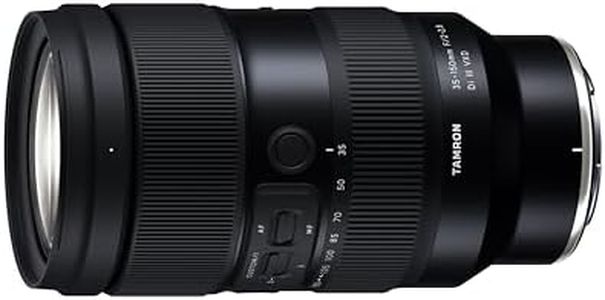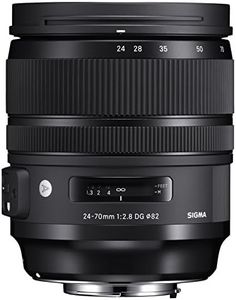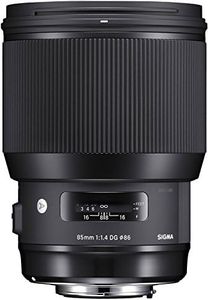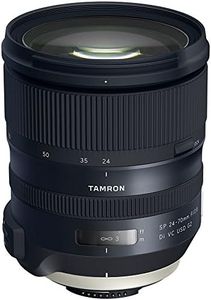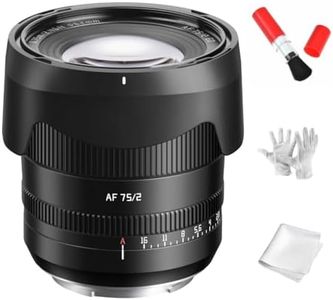We Use CookiesWe use cookies to enhance the security, performance,
functionality and for analytical and promotional activities. By continuing to browse this site you
are agreeing to our privacy policy
6 Best Nikon Lenses For Portraits
From leading brands and best sellers available on the web.Buying Guide for the Best Nikon Lenses For Portraits
Choosing Nikon lenses for portraits is all about finding the right balance between sharpness, background blur (bokeh), and how the lens renders your subject. The 'best' portrait lens depends on your camera (full-frame or crop sensor), your shooting environment (studio or outdoors), and the kind of look you want in your photos. Understanding the key features of portrait lenses will help you pick one that creates flattering results for your style.Focal LengthFocal length determines how 'zoomed in' your photos appear and influences perspective in portraits. For portraits, focal lengths usually range from about 50mm to 135mm. Shorter focal lengths (50mm-85mm) allow you to include more background and are great for half or full-body shots, while longer ones (more than 85mm) are excellent for close-ups and create a more compressed, flattering look with greater background blur. The right focal length for you depends on how much of the subject you want in the frame and how far you can stand from them—indoors, a 50mm-85mm is often best, while outdoors, you might enjoy the results from longer focal lengths.
Maximum ApertureMaximum aperture is the lowest f-number a lens can achieve (like f/1.4 or f/1.8) and affects how much light the lens lets in, as well as how blurry the background can get. Wider apertures (lower numbers) are preferred for portraits since they help isolate the subject from the background for a beautiful, soft look. Lenses with apertures of f/1.4 or f/1.8 are considered ideal for classic portraiture, letting you shoot in lower light and get dreamy backgrounds. If you want sharp portraits with lots of background separation, look for lenses with wider maximum apertures.
Autofocus PerformanceAutofocus performance is about how quickly and accurately the lens focuses on your subject. Fast and accurate autofocus is especially important when shooting moving subjects or children, and it helps cut down on blurry photos. Some portrait lenses have quiet or more advanced autofocus motors, which can be useful if you prefer not to distract your subject or if you also shoot video. If you often shoot moving people or work in fast-paced environments, pick a lens known for reliable autofocus.
Image StabilizationImage stabilization helps reduce blur from hand movement, which can happen in lower light or when using longer focal lengths. Some lenses have built-in stabilization, labeled as 'VR' in Nikon's system. While not a must-have for every portrait lens—especially at shorter focal lengths or when using a tripod—it can help you get sharper images when shooting handheld, especially in dim indoor settings or at events. It's most beneficial if you often take portraits without a tripod or in natural light.
Lens Size and WeightLens size and weight impact how comfortable it is to use the lens, especially during longer shoots. Some fast, high-quality lenses can be bulky or heavy, making them less ideal for casual or on-the-go shooting. If you plan to use your lens for extended outdoor sessions or travel, consider lighter and more compact options, even if it means sacrificing a little on aperture width.
Bokeh QualityBokeh refers to how the lens renders out-of-focus areas in your photos, which is very important in portrait photography for soft, dreamy backgrounds. The shape of the aperture blades and the lens design itself influence how smooth the background looks. Some lenses create creamy, pleasant bokeh, while others may be busier or harsher. If you want eye-catching portraits with smooth, beautiful backgrounds, research sample photos taken with the lens to examine its bokeh quality, and see if you like how it looks.
Compatibility (Mount Type and Sensor Size)Compatibility means choosing a lens that physically fits and works properly with your camera. Nikon cameras primarily use F-mount (for DSLRs) or Z-mount (for mirrorless). Also, consider whether your camera is full-frame or crop sensor (DX format). Full-frame lenses work on both, but DX lenses are designed for crop-sensor bodies. Double-check that the lens you consider matches your camera so you get the right angle of view and full functionality.
